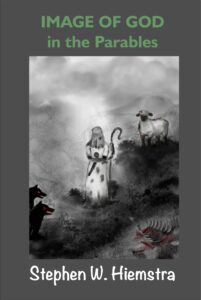The Pharisee and the Tax Collector

By Stephen W. Hiemstra
Evangelist Charles Finney (1792-1875), sometimes called the father of revivalism, was trained as a lawyer and was known to preach fire and brimstone ( Galli and Olsen 2000, 67). He intuitively understood the judicial context of mercy and the critical role played by original sin. He wrote:
“The guilty man, if he desires to have mercy from the executive, must admit the rightness of the law and of the penalty. Others he arrays himself against the law and cannot be trusted in the community.” (Finney 1999, 151)
For the accused, pleading guilty satisfies the judicial requirement for mercy because pleading not guilty implies the argument that no law has been broken. In the legal context, pleading guilty relieves the prosecutor of the burden of proving guilt and a lengthy trial, which reduces public expense.
Original sin is the doctrine that argues that although we were created sinless, sin enter the human race when Adam and Eve in eating the forbidden fruit (Gen 3:6). This is collective sin where the sin of the fathers is passed on to the children (Exod 34:7). The cycle of collective sin was broken when a sinless Christ died on the cross, paying the penalty of sin for us all. Atonement for collective sin, an event foretold by the Prophet Jeremiah (31:29-30), could only be made with a divine sacrifice.
The argument that we are all basically good (that is, are not guilty of original sin) negates the principle work of Christ, who is argued throughout the New Testament to have died for our sins (e.g. 1 Cor 15:3). No sin; no need of salvation. It also implies that Christ is not divine because Christ could not have been a sinless sacrifice for us all unless he were also God. Consequently, God’s attribute of being merciful stands as a critical argument in understanding central tenants of the Christian faith. As an attorney and evangelist, Finney played a key role in raising the common understanding of our Christian faith as well as helping found the Evangelical movement in the nineteenth century.
Lest anyone argue that the judicial understanding of mercy was a nineteenth century innovation, remember that law plays a larger role in Judaism, which provide the backdrop for the New Testament. New Testament writers wrote about Gospel in a cultural context where the legal arguments dominated everyday life.
The Pharisee and the Tax Collector
Jesus distinguished pleas of guilty versus not guilt play a key role in this parable:
”Two men went up into the temple to pray, one a Pharisee and the other a tax collector. The Pharisee, standing by himself, prayed thus: God, I thank you that I am not like other men, extortioners, unjust, adulterers, or even like this tax collector. I fast twice a week; I give tithes of all that I get. But the tax collector, standing far off, would not even lift up his eyes to heaven, but beat his breast, saying, God, be merciful to me, a sinner! I tell you, this man went down to his house justified, rather than the other. For everyone who exalts himself will be humbled, but the one who humbles himself will be exalted.” (Lk 18:9-14)
In this story, the Pharisee clearly believes that he is not guilty of having transgressed Mosaic law, while the Tax Collector sees himself as guilty. Here God plays the role of a judge who renders a verdict of justified to the Tax Collector, but not to the Pharisee. Implicit in this story is the concept of original sin because both men are judged, which is presented as culturally unexpected.
This parable focuses on the word, δικαιόω (BDAG 2005), which translates as justified. The two primary definitions have a legal context, meaning: 1.to take up a legal cause, show justice, do justice, take up a cause τινά or 2. to render a favorable verdict, vindicate. While the judge in this parable renders the verdict, no penalty is mentioned.
The absence of a penalty is interesting because this parable focuses on two devout men in the temple, which excludes secular people not in the temple whose penalty for non-worship would be culturally more obvious. The type men are explicit archetypes, one proud and the other humble. We might compare these two men with Cain and his brother Abel, who presented their gifts to God before the altar. Cain’s gift is rejected, while Abel’s is accepted by God in his unexplained, sovereign decision.
Casting two devout men in the context of worship, one accepted and the other rejected, might be taken as a first-century, literary trope, perhaps embarrassing for Pharisees or humorous to others. Before I started my career in government, I used to tell political jokes, substituting politicians’ names into airplane jokes or. even knock-knock jokes. Jesus may have done something similar here with the Parable of the Pharisee and the Tax Collector that the Gospel writers later cleaned up for a more general audience. Noting a humorous context humanizes Jesus and reinforces the focus on attitude that is given in the parable’s introduction.
References
Finney, Charles. 1999. The Spirit-Filled Life (Orig pub 1845-1861). New Kensington, PA: Whitaker House.
Galli, Mark and Ted Olsen. 2000. 131 Christians Everyone Should Know. Nashville: Broadman & Holman Publishers.
The Pharisee and the Tax Collector
Also see:
The Face of God in the Parables
The Who Question
Preface to a Life in Tension
Other ways to engage online:
Author site: http://www.StephenWHiemstra.net
Publisher site: http://www.T2Pneuma.com
Newsletter at: https://bit.ly/school_Sep2024, Signup
The post The Pharisee and the Tax Collector appeared first on T2Pneuma.net.



